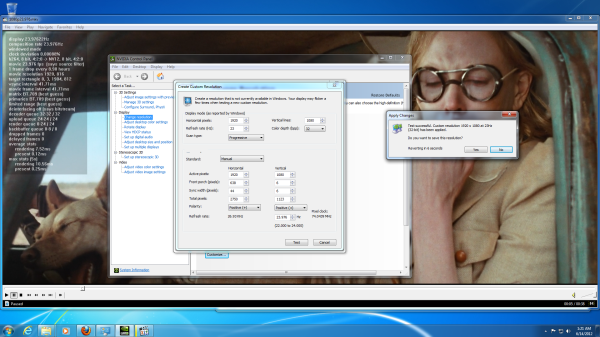Zotac GeForce GT 640 DDR3 Review: Glacial Gaming & Heavenly HTPC
by Ryan Smith & Ganesh T S on June 20, 2012 12:00 PM ESTHTPC Aspects : Custom Refresh Rates
AMD and Intel GPUs don't offer the end users an easy way to create custom refresh rates for their displays. While Intel does offer a control panel for custom timings, it is heavily tied to the EDID, rendering it unusable for the most part. On the other hand, AMD GPUs have had a history of being close to the desired refresh rates out of the box. NVIDIA's GPUs have always needed some tweaking, and the Zotac GT 640 is no different.
As we have recounted in earlier HTPC reviews, a GPU should ideally be capable of the following refresh rates at the minimum:
- 23.976 Hz
- 24 Hz
- 25 Hz
- 29.97 Hz
- 30 Hz
- 50 Hz
- 59.94 Hz
- 60 Hz
Some users demand integral multiples of 23.976 / 24 Hz because they result in a smoother desktop experience, while also making sure that the source and display refresh rates are still matched without repeated or dropped frames. The gallery below shows the refresh rate handling for 24, 25 (x2 = 50 Hz), 29.97 (x2 = 59.94 Hz), 30 (x2 = 60 Hz), 50, 59.94 and 60 Hz settings.
The native 23 Hz setting, unfortunately, resulted in a 23.9724 Hz refresh rate.
However, with some custom timing setup, we were able to achieve 23.97622 Hz, which is off by just 0.000196 Hz. In my experience, this is the closest to the optimum refresh rate that I have ever achieved with a NVIDIA card.
The custom timing feature is usable, but not without its quirks. Adding a custom resolution is straightforward. Setting the vertical parameters to values similar to the ones in the screenshot above achieves desired results, but the 23 Hz resolution gets saved as 24 Hz. We already pointed out the details in our review of the GT 540M in the ASRock Vision 3D 252B. We hope NVIDIA fixes this annoying issue in one of the upcoming driver releases.


















60 Comments
View All Comments
cjs150 - Thursday, June 21, 2012 - link
"God forbid there be a technical reason for it.... "Intel and Nvidia have had several generations of chip to fix any technical issue and didnt (HD4000 is good enough though). AMD have been pretty close to the correct frame rate for a while.
But it is not enough to have the capability to run at the correct frame rate is you make it too difficult to change the frame rate to the correct setting. That is not a hardware issue just bad design of software.
UltraTech79 - Wednesday, June 20, 2012 - link
Anyone else really disappointed in 4 still being standardized around 24 fps? I thought 60 would be the min standard by now with 120 in higher end displays. 24 is crap. Anyone that has seen a movie recorded at 48+FPS know whats I'm talking about.This is like putting shitty unleaded gas into a super high-tech racecar.
cjs150 - Thursday, June 21, 2012 - link
You do know that Blu-ray is displayed at 23.976 FPS? That looks very good to me.Please do not confuse screen refresh rates with frame rates. Screen refresh runs on most large TVs at between 60 and 120 Hz, anything below 60 tends to look crap. (if you want real crap trying running American TV on an European PAL system - I mean crap in a technical sense not creatively!)
I must admit that having a fps of 23.976 rather than some round number such as 24 (or higher) FPS is rather daft and some new films are coming out with much higher FPS. I have a horrible recollection that the reason for such an odd FPS is very historic - something to do with the length of 35mm film that would be needed per second, the problem is I cannot remember whether that was simply because 35mm film was expensive and it was the minimum to provide smooth movement or whether it goes right back to days when film had a tendency to catch light and then it was the maximum speed you could put a film through a projector without friction causing the film to catch light. No doubt there is an expert on this site who could explain precisely why we ended up with such a silly number as the standard
UltraTech79 - Friday, June 22, 2012 - link
You are confusing things here. I clearly said 120(fps) would need higher end displays (120Hz) I was rounding up 23.976 FPS to 24, give me a break.It looks good /to you/ is wholly irrelevant. Do you realize how many people said "it looks very good to me." Referring to SD when resisting the HD movement? Or how many will say it again referring to 1080p thinking 4k is too much? It's a ridiculous mindset.
My point was that we are upping the resolution, but leaving another very important aspect in the dust that we need to improve. Even audio is moving faster than framerates in movies, and now that most places are switching to digital, the cost to goto the next step has dropped dramatically.
nathanddrews - Friday, June 22, 2012 - link
It was NVIDIA's choice to only implement 4K @ 24Hz (23.xxx) due to limitations of HDMI. If NVIDIA had optimized around DisplayPort, you could then have 4K @ 60Hz.For computer use, anything under 60Hz is unacceptable. For movies, 24Hz has been the standard for a century - all film is 24fps and most movies are still shot on film. In the next decade, there will be more and more films that will use 48, 60, even 120fps. Cameron was cock-blocked by the studio when he wanted to film Avatar at 60fps, but he may get his wish for the sequels. Jackson is currently filming The Hobbit at 48fps. Eventually all will be right with the world.
karasaj - Wednesday, June 20, 2012 - link
If we wanted to use this to compare a 640M or 640M LE to the GT640, is this doable? If it's built on the same card, (both have 384 CUDA cores) can we just reduce the numbers by a rough % of the core clock speed to get rough numbers that the respective cards would put out? I.E. the 640M LE has a clock of 500mhz, the 640M is ~625Mhz. Could we expect ~55% of this for the 640M LE and 67% for the 640M? Assuming DDR3 on both so as not to have that kind of difference.Ryan Smith - Wednesday, June 20, 2012 - link
It would be fairly easy to test a desktop card at a mobile card's clocks (assuming memory type and functional unit count was equal) but you can't extrapolate performance like that because there's more to performance than clockspeeds. In practice performance shouldn't drop by that much since we're already memory bandwidth bottlenecked with DDR3.jstabb - Wednesday, June 20, 2012 - link
Can you verify if creating a custom resolution breaks 3D (frame packed) blu-ray playback?With my GT430, once a custom resolution has been created for 23/24hz, that custom resolution overrides the 3D frame-packed resolution created when 3D vision is enabled. The driver appeared to have a simple fall through logic. If a custom resolution is defined for the selected resolution/refresh rate it is always used, failing that it will use a 3D resolution if one is defined, failing that it will use the default 2D resolution.
This issue made the custom resolution feature useless to me with the GT430 and pushed me to an AMD solution for their better OOTB refresh rate matching. I'd like to consider this card if the issue has been resolved.
Thanks for the great review!
MrSpadge - Wednesday, June 20, 2012 - link
It consumes about just as much as the HD7750-800, yet performs miserably in comparison. This is an amazing win for AMD, especially comparing GTX680 and HD7970!UltraTech79 - Wednesday, June 20, 2012 - link
This preform about as well as an 8800GTS for twice the price. Or half the preformance of a 460GTX for the same price.These should have been priced at 59.99.